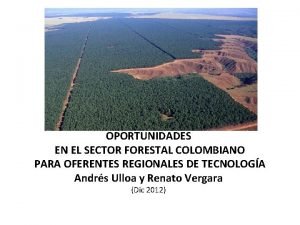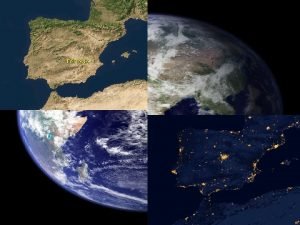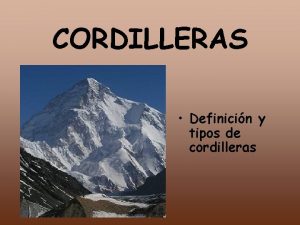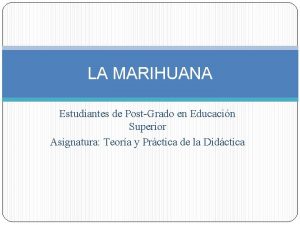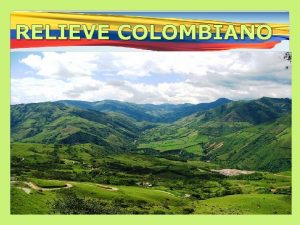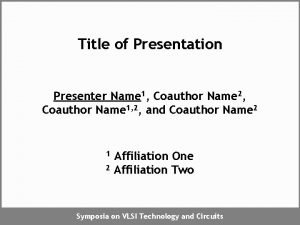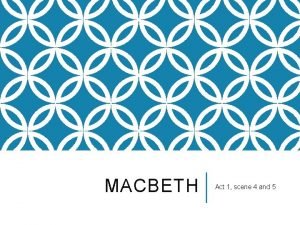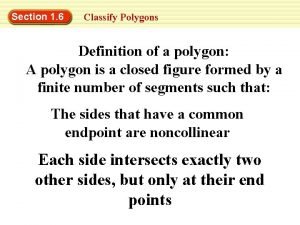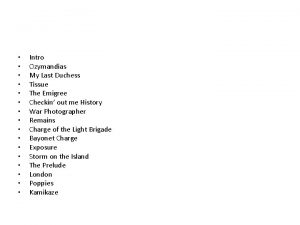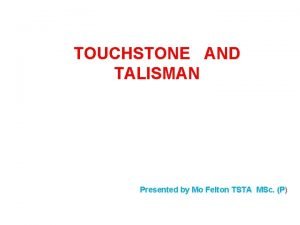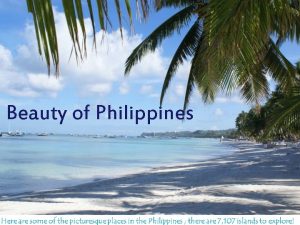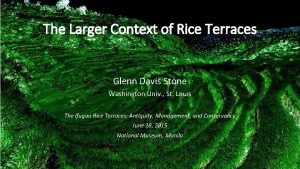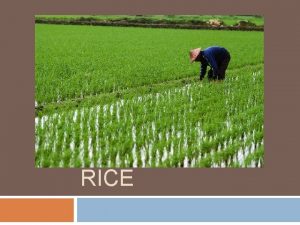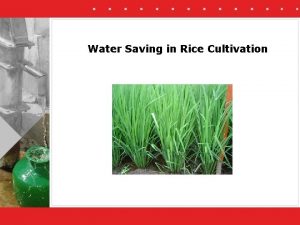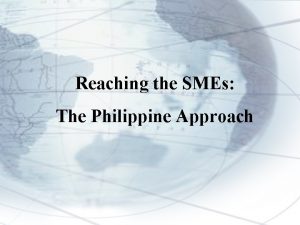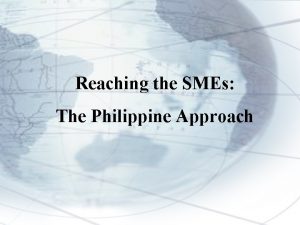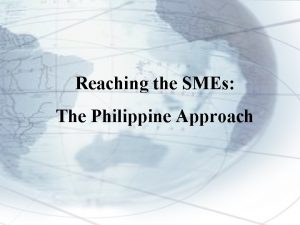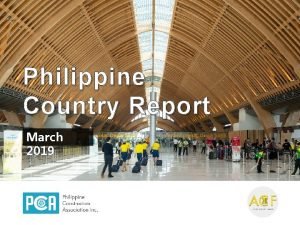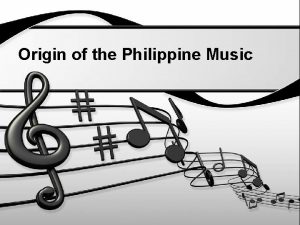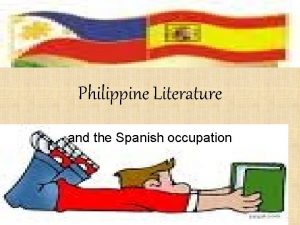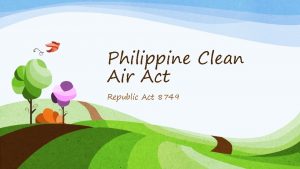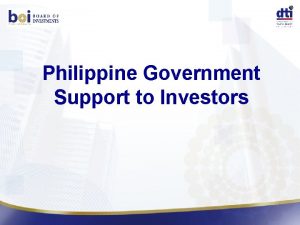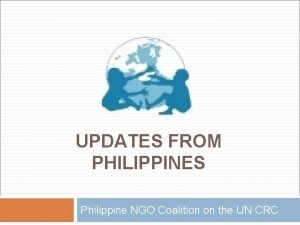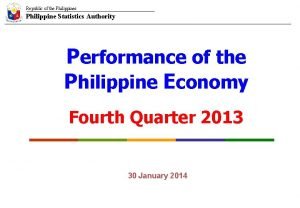Rice Terraces of the Philippine Cordilleras Philippines Presented




















- Slides: 20

Rice Terraces of the Philippine Cordilleras, Philippines Presented by Cristi Marie Nozawa Vice Chair for IUCN WCPA SEA at the Expert Meeting of the World Heritage Convention on Benchmarks and Chapter IV of the Operational Guidelines (Paris, France on April 2 -3, 2007)

History • Year of inscription on the World Heritage List: 1995 • Criteria: Cultural criteria (iii), (iv) and (v) (First in the organically evolved category) • Year of inscription on the List of World Heritage in Danger: 2001 to date

The rice terraces of the Philippines are: • outstanding examples of living cultural landscapes devoted to the production of one of the most important staple crops, rice. • remarkable degree of harmony between humankind and the natural environment of great aesthetic appeal • demonstrate sustainable farming systems in mountainous terrain

Key challenge for this living cultural landscape • “…is social- the flight of younger generations in the communities concerned to the cities” - ICOMOS & IUCN comments to the nomination in 1995

Threats and Dangers for which the property was inscribed on the List of World Heritage in Danger in 2001: • About 25 -30% of the terraces are abandoned, which has led to damage to some of the walls; • Neglect of irrigation systems and pests in farms • Irregular development heritage landscape; • Little progress has been made is taking place, which threatens to erode the in addressing the needs of tourism. For example, access from Manila and within the property remains poor

Benchmarking for the Philippine rice terraces • The 2001 mission did not identify benchmarks but made recommendations • The benchmarks were made in 2006 mission with WH Center, ICOMOS and IUCN

2001 ICOMOS-IUCN Mission objectives were: • To identify urgent conservation needs of the site; • To elaborate recommendations to the WH Committee for the enhanced management of the site • To assist the Philippine authorities in updating the existing tourism development plan, elaborating a comprehensive management plan and formulating an international assistance request for international expertise and support.

Recommendations from the 2001 ICOMOS-IUCN mission • Establish permanent & effective body • Secure Funding • Implement short term work to put the terraces back to use • Develop sustainable tourism industry • Review Master Plan • Connect the World Heritage Site with other similar sites

Benchmarking for the Philippine rice terraces • The 2001 mission did not identify benchmarks but made recommendations • The benchmarks were made in 2006 mission with WH Center, ICOMOS and IUCN

Consideration for benchmarks identification 1. UNDERSTANDING THE CULTURE AND VALUES… -local peoples’ perceptions What does World Heritage mean to local people? (like museum pieces? ) Do they recognise and accept the expectations from a World Heritage Site?

Consideration for benchmarks identification -local development status of community What are the basic needs of the living communities? What are their aspirations for development?

Consideration for benchmarks identification - functional governance mechanisms What are the other relevant agencies other than national agencies? What are the traditional governance mechanisms?

Governance Typologies • • • Government Private Civil Society Co-management Community Conserved Areas -adapted from Borrini. Feyerabend et al (in press 2006)

Consideration for benchmarks identification 2. HOW DO WE HELP SITES MOVE OUT OF THE DANGER LIST? - identify benchmarks that are achievable (avoid “killer” benchmarks), using mix of short and long term indicators, not-antidevelopment, with community ownership, sensitive to local situations (partisan politics), supports cultural diversity (5 clusters)

Consideration for benchmarks identification 3. HOW CAN BENCHMARKS SUPPORT LOCAL DEVELOPMENT ASPIRATIONS OF PEOPLE IN CULTURAL LANDSCAPES? - regaining local pride in cultures and places considered underdeveloped - encouraging use of tools (ie EIHA) for decision making for development

Consideration for benchmarks identification 4. ARE THERE INFORMATION THAT CHALLENGES THE REASONS WHY IT WAS PUT IN THE DANGER LIST? -effects of other national laws ie decentralisation and indigenous peoples laws

Consideration for benchmarks identification 5. REMEMBER WHY IT WAS INCRIBED AS WORLD HERITAGE. The people and their RICE terrace farms in mountainous conditions. The harmony of their CULTURE with their NATURAL ENVIRONMENT.

Benchmarks in 2006 a) establish a functioning management mechanism at the provincial and municipal levels, b) zoning and land-use plans responding to community-based activities and traditional value systems; c) regulations over tourism and infrastructure developments to encourage community based tourism which benefits the Rice Terraces and the local communities d) develop a resource strategy at the national, provincial, municipal and village (barangay) levels and put in place a five year plan, with top priority given to the regular mantainance and stabilisation of the rice terraces and lifeline irrigation systems so as to reverse their deterioration. e) appropriate development control procedures …where an environment impact assessment (EIA) is required for any proposed development projects. f) reforestation programme to include a wider range of endemic trees species to protect the watershed system for the rice terraces…

NO RICE NO TERRACES • FOCUS… • WORK WITH LOCAL COMMUNITY IN IDENTIFYING BENCHMARKS IN CULTURAL LANDSCAPES

MARAMING SALAMAT PO.
 Mapa físico de colombia con sus cordilleras
Mapa físico de colombia con sus cordilleras Cordilleras exteriores a la meseta
Cordilleras exteriores a la meseta Viajes pericontinentales
Viajes pericontinentales Sativa originaria de las cordilleras del himalaya
Sativa originaria de las cordilleras del himalaya Como esta formado el relieve colombiano
Como esta formado el relieve colombiano Narrow based terraces
Narrow based terraces Hyde as an outsider
Hyde as an outsider Presented sy
Presented sy Presenter name
Presenter name Drafting technical drawing
Drafting technical drawing Technological design
Technological design Presenters names
Presenters names Madtshirt
Madtshirt Macbeth soliloquy act 1 scene 4
Macbeth soliloquy act 1 scene 4 Type of polygon presented by each of the following figures
Type of polygon presented by each of the following figures My last duchess and ozymandias
My last duchess and ozymandias Talisman presented
Talisman presented The kitchen presented by
The kitchen presented by Setting of jekyll and hyde
Setting of jekyll and hyde How are the events in the text presented
How are the events in the text presented How is marley's ghost presented in stave 1
How is marley's ghost presented in stave 1
